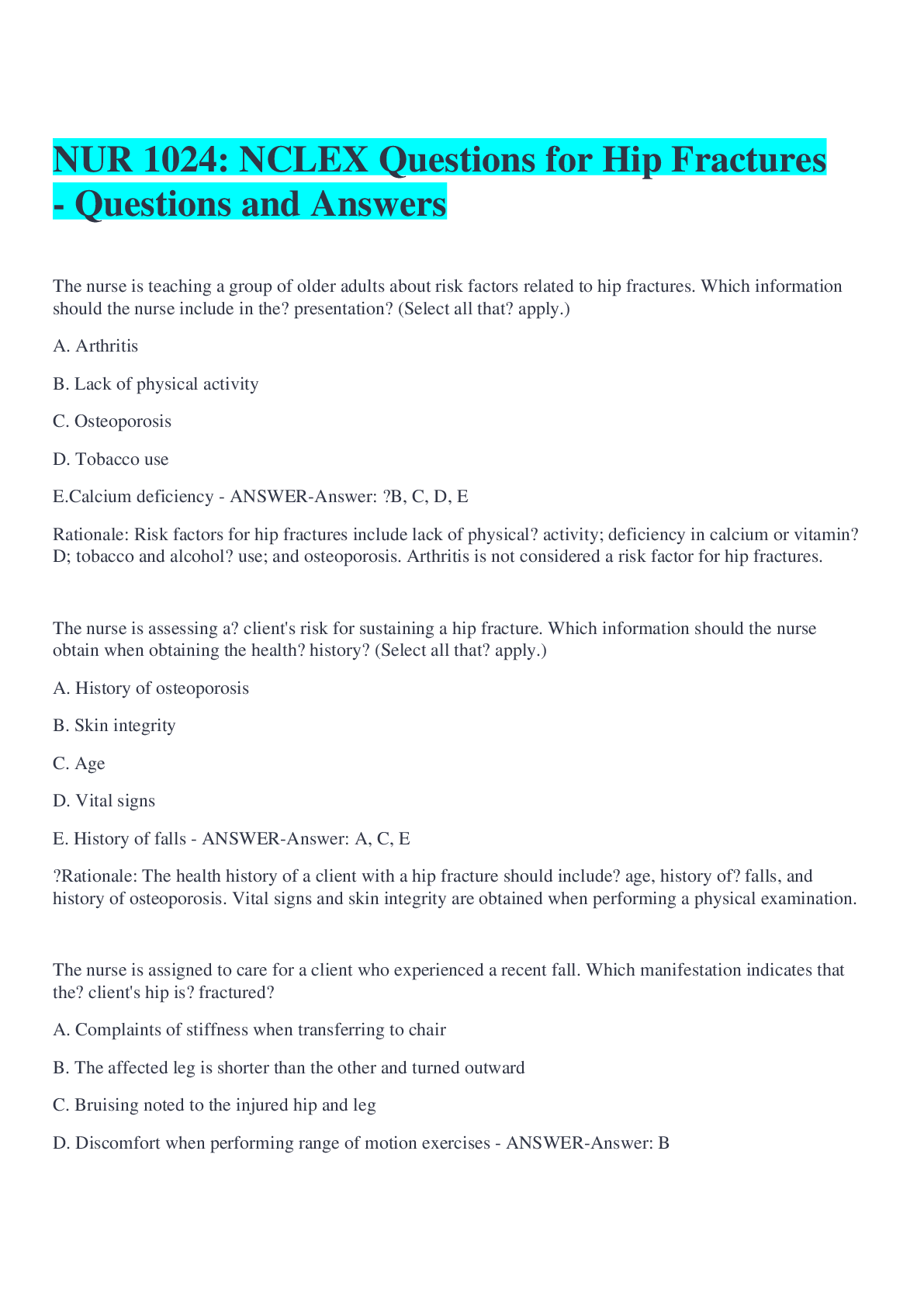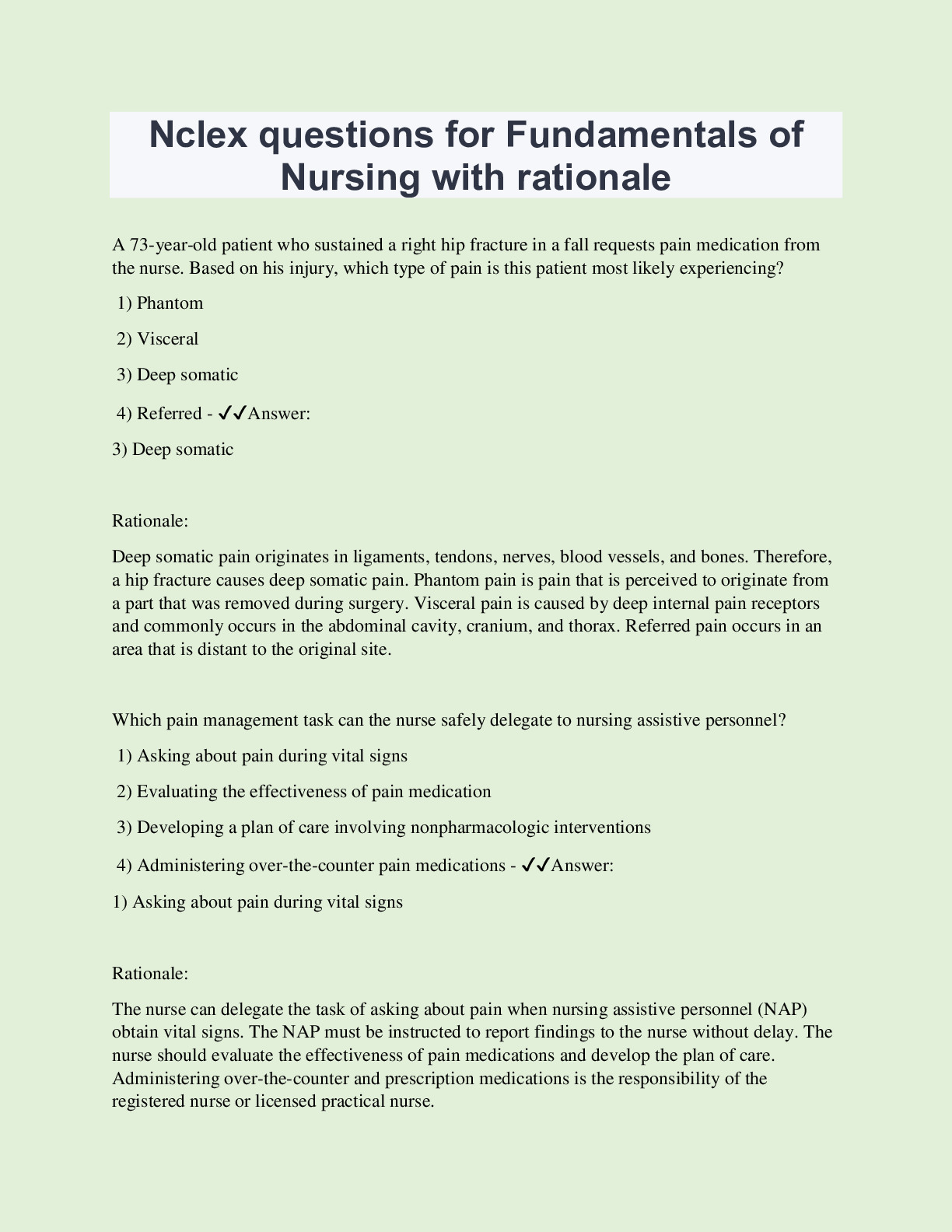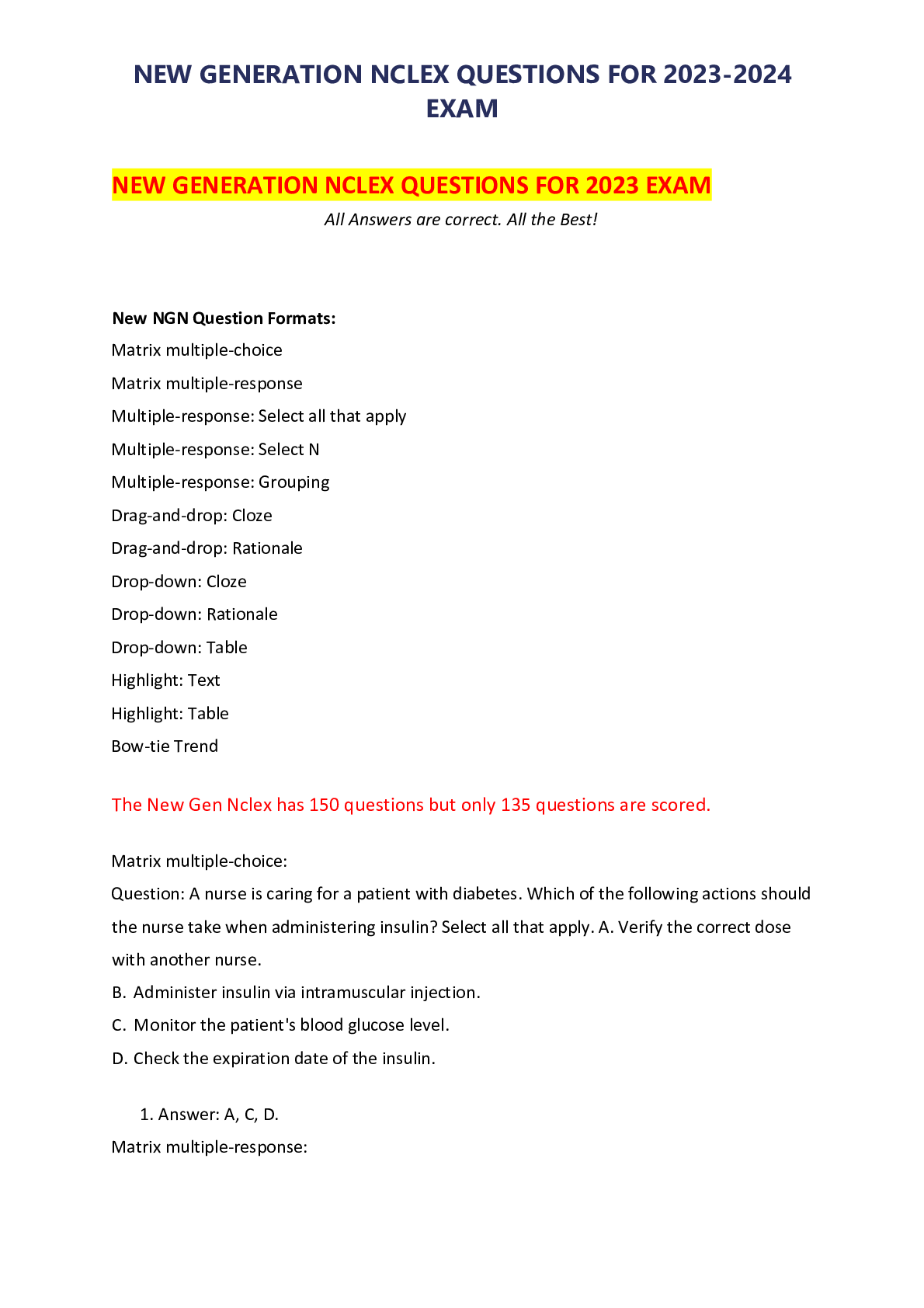NUR 1024: NCLEX Questions for Hip Fractures- Questions and Answers
Document Content and Description Below
The nurse is teaching a group of older adults about risk factors related to hip fractures. Which information should the nurse include in the presentation? (Select all that apply.) A. Arthritis B. La... ck of physical activity C. Osteoporosis D. Tobacco use E.Calcium deficiency - ANSWER-Answer: B, C, D, E Rationale: Risk factors for hip fractures include lack of physical activity; deficiency in calcium or vitamin D; tobacco and alcohol use; and osteoporosis. Arthritis is not considered a risk factor for hip fractures. The nurse is assessing a client's risk for sustaining a hip fracture. Which information should the nurse obtain when obtaining the health history? (Select all that apply.) A. History of osteoporosis B. Skin integrity C. Age D. Vital signs E. History of falls - ANSWER-Answer: A, C, E Rationale: The health history of a client with a hip fracture should include age, history of falls, and history of osteoporosis. Vital signs and skin integrity are obtained when performing a physical examination. The nurse is assigned to care for a client who experienced a recent fall. Which manifestation indicates that the client's hip is fractured? A. Complaints of stiffness when transferring to chair B. The affected leg is shorter than the other and turned outward C. Bruising noted to the injured hip and leg D. Discomfort when performing range of motion exercises - ANSWER-Answer: B Rationale: The leg of the injured hip is shorter than the uninjured leg and is sometimes turned outward in clients with hip fracture. These clients complain of severe pain, not discomfort, when flexing and rotating the hip. Bruising noted to the hip and leg may or may not be related to the fall. Complaints of stiffness may be related to the fall or from lying in bed. The nurse is caring for four clients. Which client should the nurse identify as having the highest risk for sustaining a hip fracture if they sustain a fall? A. 60-year-old man admitted for treatment of pneumonia B. 80-year-old man admitted for benign prostatic hypertrophy C. 50-year-old woman with a history of osteoarthritis D. 70-year-old woman who consumes 800 mg calcium/day - ANSWER-Answer: D Rationale: Women who are postmenopausal and not taking estrogen should consume a minimum of 1500 mg of calcium per day to maintain bone health. The 70-year-old woman who only consumes 800 mg of calcium per day is at the highest risk for a hip fracture if she falls. The 50-year-old woman may not be postmenopausal and is at a lower risk, and the men are at a lower risk. The parish health nurse notices a higher incidence of hip fractures in the church community. Which intervention should the nurse implement to help decrease the clients' risk of a hip fracture? A. Obtain assistive devices B. A walking program C. Periodic home care visits D. Use of medical alert systems - ANSWER-Answer: B Rationale: Weight-bearing exercise can decrease an individual's risk for hip fractures. Therefore, establishing a walking program would benefit the parishioners. Assistive devices would help with gait stability, but are not required by every individual. Periodic home care visits can check medication compliance and blood pressures, but will not prevent hip fractures. Medical alert systems can signal for help after a fall and fracture have occurred, but does not prevent it. The nurse is teaching an older adult client about preventing hip fractures. Which information should the nurse include? (Select all that apply.) A. Obtaining a screening to test for osteoporosis B. Maintaining adequate intake of calcium and vitamin D C. Ensuring throw rugs are placed throughout the home D. Performing weight-bearing exercises daily E. Drinking one glass of red wine every night - ANSWER-Answer: A, B, D Rationale: Teaching the client about avoiding falls can be helpful in preventing hip fractures. Weight-bearing exercises increase strength and adequate intake of calcium and vitamin D helps bone health. Screening for osteoporosis can lead to early treatment to help diminish the risk of bone fractures. Throw rugs are not recommended because the client can trip or slip on them. There is no recommendation to drink red wine; in fact, alcohol should be consumed with caution as it can impair balance and increase the risk for a fall. The nurse assesses an older adult woman and determines the client is at high risk for osteoporosis and hip fractures. Based on these findings, which test should the nurse request from the healthcare provider? A. Computerized tomography (CT) scan B. Bone density testing C. Magnetic resonance imaging (MRI) scan D. X-rays - ANSWER-Answer: B Rationale: Postmenopausal women with low calcium intake are at a very high risk of osteoporosis and hip fractures. Therefore, the healthcare provider will prescribe bone density testing to determine further treatment. X-rays, CT scans, and MRIs are used to diagnose hip fractures. The home care nurse is visiting an older adult client with a new diagnosis of macular degeneration and decreased visual acuity. Which instruction should the nurse provide the caregiver to decrease the client's risk of sustaining a fall and a hip fracture? (Select all that apply.) A. Remove throw rugs B. Clear pathways C. Eliminate alcohol D. Use night-lights E. Increase calcium - ANSWER-Answer: A, B, D Rationale: An older adult client with decreased visual acuity is at high risk for falling. Therefore, the nurse would instruct the family to clear the pathways, use night-lights, and remove throw rugs. Calcium should be increased for postmenopausal women. Excessive alcohol intake should be avoided. The nurse is caring for an 8-year-old child who sustained a hip fracture from a motor vehicle crash. The parents ask if the child will be scheduled for a hip replacement. How should the nurse respond? A. "Treatment for hip fractures in children often involves casting for 4 to 6 weeks." B. "Hip replacements are not done in children because they need to be revised with growth." C. "We will place the child in traction for a few days, then do the hip replacement." D. "A hip replacement will be performed once the child is medically stable." - ANSWER-Answer: A Rationale: Hip fractures in children are usually treated with casting for 4 to 6 weeks or repair surgery rather than hip replacement surgery. Hip replacements begin to fail at 10 years and require revision surgery. An older adult client sustained a hip fracture secondary to a fall and undergoes an arthroplasty. The client refuses to get out of bed due to pain and fatigue. Which response by the nurse is correct? A. "It is okay to rest today, but you need to participate tomorrow." B. "You have to get out of bed today because the healthcare provider ordered it." C. "Early ambulation promotes healing and reduces complications." D. "We will give you pain medication after you get up and participate in therapy." - ANSWER-Answer: C Rationale: The nurse should inform the client that getting out of bed the first postoperative day will decrease complications and improve mobility. The nurse would not tell the client it is okay to wait one day. The nurse would not inform the client that they need to get out of bed because the healthcare provider ordered it. This is not therapeutic communication and does not provide information. Pain medication should be administered prior to therapy, not after. Which information should the nurse provide a 70-year-old client to prevent falls and hip fractures? (Select all that apply.) A. Having an eye exam every year B. Limiting cigarette smoking C. Taking 500 mg of calcium every day D. Participating in weight-bearing exercises E. Avoiding excessive alcohol use - ANSWER-Answer: A, D, E Rationale: Yearly eye exams, daily weight-bearing exercises, and avoiding excessive alcohol use are interventions to help reduce falls and prevent hip fractures. Any amount of cigarette smoking places a client at risk of hip fractures; the client needs to refrain from smoking altogether. A postmenopausal woman who is not on estrogen replacement should take 1,500 mg of calcium daily. Which information should the nurse include in discharge teaching for a client who had a hip arthroplasty? A. "Extend the operative leg backward." B. "Use an elevated toilet seat." C. "Restrict motion for 2 weeks." D. "Place an abduction pillow between the legs only at night." - ANSWER-Answer: Rationale: A client who had a hip arthroplasty should use an elevated toilet seat and shower chair to prevent excess flexion of the hip. It is important for the client to ambulate throughout the day and to not restrict motion, including extending the legs backwards. An abduction pillow, if ordered, should be used when sleeping, including during the night and when resting during the day. Which pharmacologic treatment should the nurse expect the healthcare provider to prescribe to a client with osteoporosis to prevent hip fractures? A. Selective serotonin reuptake inhibitors (SSRIs) B. Loop diuretics C. Incretin mimetic agents D. Bone density enhancers - ANSWER-Answer: D Rationale: Bone density enhancers (e.g., bisphosphonates) stimulate bone growth and can be administered to clients with osteoporosis to prevent hip fractures. Incretin mimetic agents, SSRIs, and loop diuretics are not indicated in the treatment of osteoporosis to prevent hip fractures. The nurse is providing a seminar about hip fracture treatment in the older adult. Which surgery should be included? (Select all that apply.) A. Fractional ablation B. Open internal fixation C. Arthroplasty D. Hemiarthroplasty E. Appendectomy - ANSWER-Answer: B, C, D Rationale: Hemiarthroplasty is a partial hip replacement of the ball or head of the femur. Arthroplasty is a total replacement of the ball and socket or head and acetabulum of the hip joint. Open internal fixation is performed to align the bone when placing hardware. Appendectomy and fractional ablation are not indicated for hip fractures. A client diagnosed with a hip fracture is scheduled for an arthroplasty. Which information should the nurse provide when describing this type of surgery to the client? A. Insertion of an intramedullary nail into the marrow canal of the bone via an opening made in the greater trochanter B. Replacement of the ball and socket or head and acetabulum of the hip joint C. Percutaneous pinning or compression hip screws that slide within the barrel of the plate D. Partial replacement of the ball or head of the femur - ANSWER-Answer: B Rationale: Arthroplasty is a total replacement of the ball and socket or head and acetabulum of the hip joint. Partial hip replacement of the ball or head of the femur is a hemiarthroplasty. Insertion of an intramedullary nail into the marrow canal of the bone via an opening made in the greater trochanter is hardware placed when a client has an extracapsular fracture. Percutaneous pinning or compression hip screws that slide within the barrel of the plate is hardware placed when a client has an intracapsular fracture. A client with a hip fracture has undergone surgery for insertion of a hip prosthesis. Which activity should the nurse instruct the client to avoid? A. Using an abductor pillow while lying on the side B. Sitting in a reclining chair C. Performing weight-bearing exercises daily D. Sitting on a raised commode - ANSWER-Answer: C Rationale: Weight-bearing exercises should not be resumed until the healthcare provider or physical therapist instructs the client it is safe to do so. Any activity that causes flexion, adduction, or internal rotation should be avoided. Using an abductor pillow, sitting in a reclining chair, or using a raised commode prevents hip flexion and adduction. The nurse is caring for a client following the surgical repair of a hip fracture. Which intervention assists in reducing the risk of a deep vein thrombosis (DVT)? (Select all that apply.) A. Positioning an abduction pillow between the legs B. Administering anticoagulants as prescribed C. Using an incentive spirometer every hour D. Placing compression stockings on the client E. Turning the client every 2 hours - ANSWER-Answer: B, D Rationale: To reduce the risk of a DVT, administer anticoagulants as prescribed and place compression stockings on the client. Using an incentive spirometer reduces the risk of pneumonia. Turning the client every 2 hours prevents skin breakdown. Positioning an abduction pillow between the legs keeps the surgical hip in alignment. The nurse is preparing to send the client who is one-day postoperative from a hip arthroplasty for physical therapy. Which intervention should the nurse perform first? A. Administer analgesics B. Provide the client lunch C. Administer a diuretic D. Apply sequential compression stockings - ANSWER-Answer: A Rationale: The nurse should administer analgesics about 30-60 minutes prior to attending physical therapy. This minimizes pain during exercise and allows better movement. The nurse would not administer a diuretic prior to going to therapy because the client would have to urinate frequently. The client can eat lunch, but it is not a priority. Sequential stockings can only be used while the client is in bed. Which intervention should the nurse include in the plan of care to prevent infection for a client who is recovering from a hip replacement? A. Administer anticoagulants as prescribed. B. Remove staples 3-5 days after surgery. C. Keep the incision clean and dry. D. Refrain from moving the hip joint. - ANSWER-Answer: C Rationale: The nurse should keep the incision clean and dry and assess for signs of infection. The client should be encouraged to move the new hip joint to increase mobility. Staples are usually removed 10-14 days after surgery. Anticoagulants prevent deep vein thromboses, not infection. The nurse is assessing the neurovascular status of a child who is in a hip spica cast for a hip fracture. Which finding indicates the child has good circulation to the affected limb? A. Pallor B. Paralysis C. Pain 1/10 D. Paresthesia - ANSWER-Answer: C Rationale: The nurse should assess the neurovascular status of a client in a spica cast. This includes assessing color, temperature, and sensation. A pain level of 1/10 indicates good circulation. Pallor, paralysis, and paresthesia indicate circulatory deficits and need to be reported to the healthcare provider. [Show More]
Last updated: 1 year ago
Preview 1 out of 7 pages

Reviews( 0 )
Recommended For You
*NURSING> EXAM > NUR2 571 Gastrointestinal - exam 1 notes T-Tube NCLEX Questions for Nursing Care (All)

NUR2 571 Gastrointestinal - exam 1 notes T-Tube NCLEX Questions for Nursing Care
NUR2 571 Gastrointestinal - exam 1 notes T-Tube NCLEX Questions for Nursing Care
By alvin , Uploaded: Dec 24, 2020
$16
*NURSING> EXAM > Nclex questions for Fundamentals of Nursing Questions And Answers with rationale 2022 (All)

Nclex questions for Fundamentals of Nursing Questions And Answers with rationale 2022
Nclex questions for Fundamentals of Nursing Questions And Answers with rationale 2022
By ELIANA , Uploaded: Aug 26, 2022
$12
*NURSING> EXAM > NEW GENERATION NCLEX QUESTIONS FOR 2023 EXAM (All)

NEW GENERATION NCLEX QUESTIONS FOR 2023 EXAM
NEW GENERATION NCLEX QUESTIONS FOR 2023 EXAM
By Thirty3 , Uploaded: Aug 05, 2023
$14
*NURSING> EXAM > NEW GENERATION NCLEX QUESTIONS FOR 2023-2024 EXAM (All)

NEW GENERATION NCLEX QUESTIONS FOR 2023-2024 EXAM
NEW GENERATION NCLEX QUESTIONS FOR 2023-2024 EXAM
By Quizsolution , Uploaded: Jan 22, 2024
$15
*NURSING> EXAM > NEW GENERATION NCLEX QUESTIONS FOR 2023 EXAM (All)

NEW GENERATION NCLEX QUESTIONS FOR 2023 EXAM
NEW GENERATION NCLEX QUESTIONS FOR 2023 EXAM
By ClemBSC , Uploaded: Aug 03, 2023
$14
*NURSING> EXAM > NEW GENERATION NCLEX QUESTIONS FOR 2023 EXAM (All)

NEW GENERATION NCLEX QUESTIONS FOR 2023 EXAM
NEW GENERATION NCLEX QUESTIONS FOR 2023 EXAM
By Examiner101 , Uploaded: May 17, 2023
$14
*NURSING> EXAM > NEW GENERATION NCLEX QUESTIONS FOR 2023 EXAM (All)

NEW GENERATION NCLEX QUESTIONS FOR 2023 EXAM
NEW GENERATION NCLEX QUESTIONS FOR 2023 EXAM
By rrugeruni , Uploaded: Aug 05, 2023
$12
nurse> EXAM > NEW GENERATION NCLEX QUESTIONS FOR 2023 EXAM (All)

NEW GENERATION NCLEX QUESTIONS FOR 2023 EXAM
NEW GENERATION NCLEX QUESTIONS FOR 2023 EXAM
By FlashDocs , Uploaded: May 17, 2023
$12.5
*NURSING> EXAM > NEW GENERATION NCLEX QUESTIONS FOR 2023 EXAM (All)

NEW GENERATION NCLEX QUESTIONS FOR 2023 EXAM
NEW GENERATION NCLEX QUESTIONS FOR 2023 EXAM
By durkio40 , Uploaded: Aug 06, 2023
$15
*NURSING> EXAM > NEW GENERATION NCLEX QUESTIONS FOR 2023 EXAM (All)

NEW GENERATION NCLEX QUESTIONS FOR 2023 EXAM
NEW GENERATION NCLEX QUESTIONS FOR 2023 EXAM
By BrowseDocu , Uploaded: May 17, 2023
$12
Document information
Connected school, study & course
About the document
Uploaded On
Jan 16, 2023
Number of pages
7
Written in
Additional information
This document has been written for:
Uploaded
Jan 16, 2023
Downloads
0
Views
40






